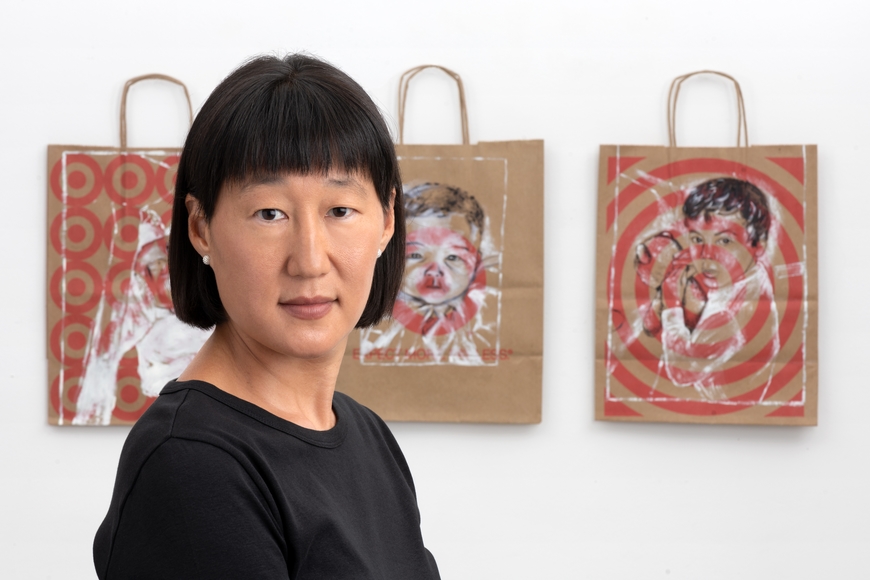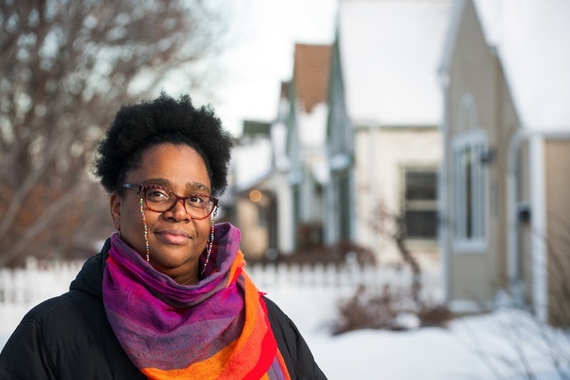Rye’s art rooted in experience from foundling to “forever home”
Megan Rye (MFA ‘03, art) is a visual artist and teacher who was born in Seoul, South Korea in 1975. Through paintings, drawings, photography, and artist books, Rye explores themes of migration, citizenship, remembrance, war, and democracy. Rye graduated from the Rhode Island School of Design with a BFA in painting in 1994. After receiving her MFA from the University of Minnesota, she attended the Skowhegan School of Painting and Sculpture. She has received numerous honors and grants, including from the Minnesota State Arts Board, and the Jerome, McKnight, and Bush foundations.
Rye's current project Foundling: 100 Days is on exhibit at the Weisman Art Museum through May '21. It includes portraits of herself and fellow internationally adopted children. The portraits, inspired by adoption file referral photographs, debuted at the Spencer Museum of Art, Lawrence, Kansas (2019). Rye is represented by Forum Gallery in New York City. Rye answered several questions about the exhibit and her life as an artist:
What do you think is accomplished through art as a way to bear witness to the international adoption experience?
Foundling: 100 Days celebrates the creation of family through adoption. Foundling, by centering the adoption experience through the eyes of adoptees, also engages with the complexities and challenges inherent on the long journey to a forever home.
When international adoption peaked in the 1980s, adoption was understood through the lens of our American parents. After all, we were babies or young children. As adoptees have come of age, we are now in a position to tell our own stories.
Foundling: 100 Days is a unique public art project that facilitates both my artistic vision and the perspective of 73 adoptees. I am the creator of the portraits. Yet, an essential part of the exhibit is a collection of stories from the adoptees, whose portraits are exhibited. These powerful reflections, memories, and adoption case histories have become the beating heart of the exhibit.
Describe how the practice of Baek-il (the practice of celebrating an infant on the 100th day after birth) offered inspiration for the project and find its way into your work.
In Korea, they celebrate the 100th day of an infant’s life. Historically, if a baby made it to 100 days, there was the promise they would see their first year and beyond. These 100 paintings of 73 adoptees, similarly commemorate survival. From one’s birth country to America. From homelessness to a forever family. From foundling to citizen.
Yet survival and arrival are merely the first steps. Adoptees find home and discover identity, again and again throughout life. We travel back to our birth countries or wait for later. We decide to search for a birth family or not. We are aware of the possibility of DNA testing and social media that might connect us to our past. We were integrated into our Minnesota surroundings, yet are cognizant of the countries we left behind. Adoptees navigate, assimilate, and reconcile.
When did you come upon art as your passion and calling?
I have created art my entire life. I was very fortunate to have parents who completely supported a creative path and to grow up in the Twin Cities, which has professional-level classes even for young children. Art is my constant companion. It is how I see and understand the world.
What was a memorable experience or relationship encountered as a result of your time earning your MFA in CLA?
Professor Joyce Lyon (art) gave an artist talk that was astounding. She showed a series of paintings responding to World War II history. The first images she shared were figurative works that were very literal and concrete in their depiction of events. Yet ultimately she concluded it would be more powerful to speak in metaphor. She ended up weaving themes of the Holocaust into a series of landscape paintings. These hauntingly beautiful backyard paintings changed the way I visualized and understood not only landscape but painting itself.
Professor Lyon offered both unconditional support and criticism in moments I needed creative direction and philosophical guidance. Her counsel and advocacy did not end at graduation. We are still connected today.
Against current tensions around immigration in this country and the world, and considering what you’ve learned through Foundling: 100 Days, what would you want everyone to know?
Seventy percent of the adoptees in this project come from South Korea and China. Guatemala, Paraguay, Ethiopia, Colombia, India, Russia, and Romania are also represented.
Our country, a nation of immigrants, continues to have a complicated relationship with immigrants. This project was conceived in 2016, under a president whose attitude towards refugees and immigrants was often to “go back home.” And since the beginning of the pandemic over 11,000 incidences of anti-Asian hate crimes have been committed.
In the face of this animosity, this exhibit is my statement of legitimacy. It is a gesture of narrative permanence. It is the profound act of becoming visible and seeing ourselves represented in the world.
It is fitting the Weisman Museum is the Minnesota home for this exhibit. At a small gathering of museum friends, as we were standing in a circle saying goodbye, Weisman’s new director Alejandra Pena Gutierrez looked around at us and remarked, “We are all immigrants here.” I am so proud and thankful the Weisman has a truly global leader, alongside senior curator Diane Mullin, who will shepherd this project forward into the world.
Explore more about the adoptee experience
Explore an additional perspective about the immigrant and international adoptee experience: For the past 20 years, Professor Rich Lee (Psychology) has been studying the lives of Korean youths adopted internationally by white families and focuses on the ways in which race, ethnicity, migration experiences, affect human development in youth and families. His research reveals how Korean adoptees raised in white families learn about their heritage culture, and how to negotiate race in the United States.



